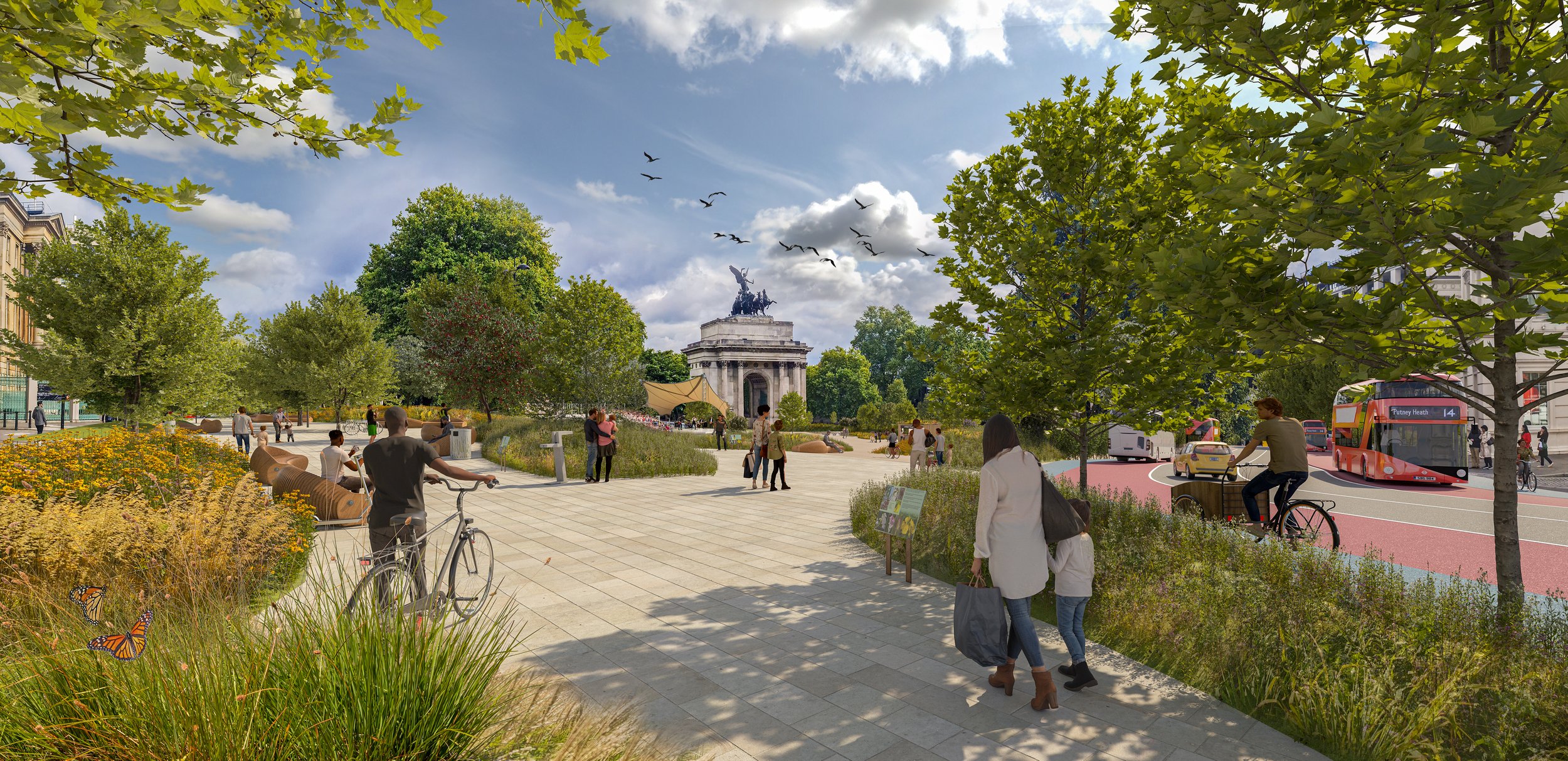Car Free Visions: Hyde Park Corner
This Autumn, we held a workshop with residents, and interviewed experts, to re-imagine Hyde Park Corner in a future free from car dependency. We polled Londoners and found overwhelming support for our visions!
Hyde Park Corner is currently a roundabout and an urban motorway with between four and six lanes for motor traffic. Six streets feed into this busy junction, and the A4 runs directly underneath it.
But it wasn’t always like this. Hyde Park Corner was thought of unofficially as the entrance to London.
The below picture from the early 1890s shows horses and carriages sharing the space with pedestrians. At this time, it’s estimated that there were no more than 15 cars in Britain.
By 1900 there were approximately 700 cars in Britain and this figure continued to shoot up so by 1930 there were 1 million cars in Britain. The below picture shows a postcard of Hyde Park Corner from 1937 shows what the number of cars were beginning to do to our streetspace.
By 1948, Hyde Park Corner is being described as “one of the capital’s busiest traffic junctions” as seen in this short clip.
So we brought together 9 Londoners from diverse backgrounds to discuss, explore, and workshop ideas of what a utopic future could look like. Read more about the workshop.
This is what they came up with.
It is a late afternoon on Saturday 20th July 2030. You’ve just left a beautiful picnic in Hyde Park and are making your way over to Green Park.
You begin to cross the large, expansive civic space that now surrounds Wellington Arch. You enjoy strolling down the wide walkways lined with lush green trees, the shade and the cooling breeze are most welcome. Birds fly in the sky, butterflies dance amongst the flora. There are boards explaining the rich biodiversity in the area.
Sounds of life surround you: some teens are excitedly recording a routine for their social media; a family is trying to get their toddler to take their first steps; a food delivery driver is taking a break before their next gig and helps themselves to some fruit from the fruit tree; an older person is lying on the smooth, comfortable benches, taking it all in.
People can cycle through here - and with the blue protected cycleways many, many people do - but pedestrians ultimately have right of way. There’s lots of cycle storage nearby with charging points for e-bikes - all solar powered.
As you get closer to the arch, you catch glimpses of music - one of the many free public concerts that get put on in the amphitheatre. You stop at a drinking fountain to fill up your water bottle and pause to savour the melody.
You smile to yourself as you remember that just a few years ago, this place was a polluting, congested road junction. Now it’s calmer, safer, healthier, happier - a place for people and nature, not cars.
This vision is very achievable.
We want to do to Hyde Park Corner what was long ago done to Trafalgar Square when the National Gallery was reunited with Nelson’s column and the square.
We want to peninsulise it, stopping traffic on two arms and turning the area into land for people to easily walk from Hyde Park to the Wellington Arch. Buses and taxis can still go through.
We also want bus lanes all around the revised set of two-way roads and the managing of other vehicle flows down to one lane in either direction.
In November 2022, we polled 1073 adults living in London on whether they would support the pedestrianisation of Hyde Park Corner to link it up with Green Park - 49% of respondents supported the idea, 27% opposed the idea, and 24% did not know.
But support shot up to 72% when people saw our vision and were then asked for their views again - this shows the importance of visuals to help raise support for a car free future.
Want to see our visions for Paris and New York City?
In Autumn 2022, we held workshops in our megacities to re-imagine iconic places - the Place de la Concorde in Paris, the Grand Army Plaza in New York, and Hyde Park Corner in London - in a future free from car dependency.
What you can do to support a car free future
For those in the UK:
Sign up to our mailing list for further actions and to stay up to date with the campaign.
Read about our traffic filter survey and show your local council that the public support them.
Find out all about parklets and ask your local council to support parklets.
Use our map to send a letter to your councillor calling for school streets to reduce children’s exposure to toxic air pollution.
Take on our 30-day car free challenge!
For those anywhere in the world:
Turning our visions into reality means having tough conversations about taking cars out of cities. Download our guide on "How to talk about car free cities" so you can help people get past their concerns and respond to common criticisms.
Explore our stories of change map showcasing traffic reduction measures from all around the world and share your own story with us by filling out this form.






